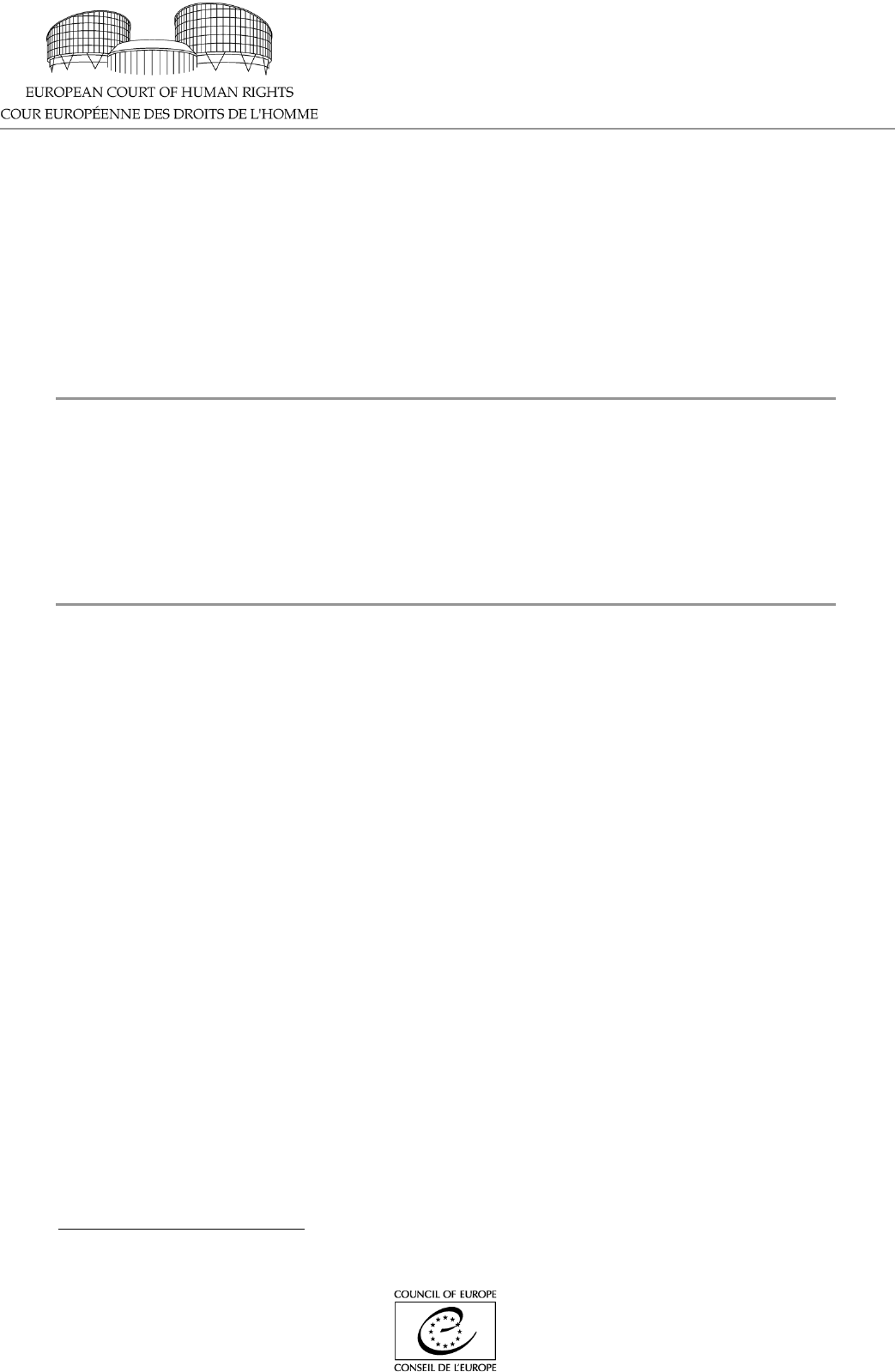
ECHR-KS
Key Theme – Summary returns of migrants and/or asylum-seekers (“push-backs”)
and related case scenarios
KEY THEME
1
Article 4 of Protocol No. 4 and Immigration
Summary returns of migrants and/or asylum-seekers
(“push-backs”) and related case scenarios
(Last updated: 29/02/2024)
Introduction
While States have the right, as a matter of well-established international law and subject to their
treaty obligations (including the Convention), to control the entry, residence and expulsion of non-
nationals, there are certain limitations on the right of States to turn someone away from their
borders, notably the principle of non-refoulement. The Court has dealt with summary returns of
(groups of) individuals on the high seas, at land borders and shortly after entry into the territory. It
has done so under different Convention provisions.
Principles drawn from the current case-law
Exercise of jurisdiction within the meaning of Article 1 of the Convention:
▪ An interception by the coastguard of the respondent State on the high seas and events on
board that State’s military vessels constitute an exercise of extraterritorial jurisdiction by a
respondent State within the meaning of Article 1 (Hirsi Jamaa and Others v. Italy [GC],
2012, §§ 76-82), also engaging that State’s responsibility under Article 4 of Protocol No. 4,
where the effect is to prevent migrants from reaching the borders of the State or even to
push them back to another State (ibid., §§ 169-182).
▪ A control, with a view to deciding whether to grant leave to enter carried out by border
guards of the respondent State on board of a vessel anchored in one of its ports, has also
been considered to fall within the jurisdiction of that State for the purposes of Article 1:
see Kebe and Others v. Ukraine, 2017, §§ 75-77.
▪ Actions by the respondent State’s border guards or police officers at a land border fall
within the territorial jurisdiction of a State:
Events at border fences erected on the respondent State’s territory: N.D. and N.T.
v. Spain [GC], 2020, §§ 104-111;
Refusal to accept asylum applications and denial of entry decisions at land border check
points: M.A. and Others v. Lithuania, 2018, § 70; M.K. and Others v. Poland, 2020,
§§ 129-132; D.A. and Others v. Poland, 2021, §§ 33-34;
Actions by soldiers of the respondent State on the respondent State’s territory,
including if police officers from other States had come to help the authorities of the
respondent State in managing a mass influx of migrants: A.A. and Others v. North
Macedonia, 2022, §§ 57-64.
1
Prepared by the Registry. It does not bind the Court.

Key Theme – Summary return of migrants and/or asylum-seekers (“push-backs”) and related case scenarios
ECHR-KS
2/13
Article 3 of the Convention: Removal to a third country:
In its judgment Ilias and Ahmed v. Hungary [GC], 2019, the Court set out the following general
principles for cases concerning the removal of asylum-seekers to third intermediary countries,
without an assessment, by the authorities of the removing State, of the merits of the asylum claim:
▪ Where a Contracting State seeks to remove an asylum-seeker to a third country without
examining the asylum request on the merits, the State’s duty not to expose the individual
to a real risk of treatment contrary to Article 3 is discharged in a manner different from
that in cases of return to the country of origin. In the former situation, the main issue is the
adequacy of the asylum procedure in the receiving third country. While a State removing
asylum-seekers to a third country may legitimately chose not to deal with the merits of the
asylum requests, it cannot therefore be known whether those persons risk treatment
contrary to Article 3 in the country of origin or are simply economic migrants not in need of
protection. It is the duty of the removing State to examine thoroughly whether or not
there is a real risk of the asylum-seeker being denied access, in the receiving third country,
to an adequate asylum procedure, protecting him or her against refoulement, namely,
against being removed, directly or indirectly, to his or her country of origin without a
proper evaluation of the risks he or she faces from the standpoint of Article 3 of the
Convention. If it is established that the existing guarantees in this regard are insufficient,
Article 3 implies a duty not to remove the asylum-seeker to the third country concerned
(Ilias and Ahmed v. Hungary [GC], 2019, §§ 130-138).
▪ To determine whether the removing State has fulfilled its procedural obligation to assess
the asylum procedures of a receiving third State, it has to be examined whether the
authorities of the removing State had thoroughly examined the available general
information about the receiving third country and its asylum system in an adequate
manner and of their own initiative; and whether an applicant had been given a sufficient
opportunity to demonstrate that the receiving State was not a safe third country in his or
her particular case. In applying this test, the Court indicated that any presumption that a
particular country is “safe”, if it has been relied upon in decisions concerning an individual
asylum-seeker, must be sufficiently supported at the outset by the above analysis (Ilias and
Ahmed v. Hungary [GC], 2019, §§ 139-141, 148 and 152).
▪ Importantly, in cases concerning the removal to a third country based on the “safe third
country” concept, that is, where the authorities of the removing State have not dealt with
the merits of the applicant’s asylum claim, it is not the Court’s task to assess whether there
was an arguable claim about Article 3 risks in the country of origin, this question only being
relevant where the expelling State had dealt with these risks (Ilias and Ahmed
v. Hungary [GC], 2019, § 147).
▪ In addition to the main question whether the individual will have access to an adequate
asylum procedure in the receiving third country, where the alleged risk of being subjected
to treatment contrary to Article 3 concerns, for example, conditions of detention or living
conditions for asylum-seekers in a receiving third country, that risk is also to be assessed by
the expelling State (Ilias and Ahmed v. Hungary [GC], 2019, § 131). It is recalled that the
removal of asylum-seekers to a third country may be in breach of Article 3 because of
inadequate reception conditions in the receiving State (M.S.S. v. Belgium and Greece [GC],
2011, §§ 362-368) or because they would not be guaranteed access to reception facilities
adapted to their specific vulnerabilities, which may require that the removing State obtains
assurances from the receiving State to that end (Tarakhel v. Switzerland [GC], 2014,
§§ 100-122; Ali and Others v. Switzerland and Italy (dec.), 2016; Ojei v. the
Netherlands (dec.), 2017).

Key Theme – Summary return of migrants and/or asylum-seekers (“push-backs”) and related case scenarios
ECHR-KS
3/13
The Court applied these principles to cases in which applicants, who had sought to lodge an asylum
application with, and/or communicate fear for their safety to border officials, were denied entry to
the territory and were removed in a summary manner to a third country. The Court found that there
had been a violation of Article 3 of the Convention in those cases (M.K. and Others v. Poland, 2020,
D.A. and Others v. Poland, 2021, O.M. and D.S. v. Ukraine, 2022, and S.S. and Others v. Hungary,
2023; for a case concerning a similar factual scenario, but predating the judgment in Ilias and Ahmed
v. Hungary [GC], 2019, see M.A. and Others v. Lithuania, 2018; see also Sharifi and Others v. Italy and
Greece, 2014, §§ 226-235, where the Court examined the applicants’ complaint that they were at
risk of indirect refoulement to their country of origin, Afghanistan, and found that their summary
return from Italy to Greece had breached Article 3 of the Convention), including where domestic law
provided that asylum applications could not be lodged at the border crossing point (airport) at which
the applicants presented themselves but could only be lodged at a land border transit zone (S.S. and
Others v. Hungary, 2023, §§ 62-63). The following, additional, principles can be drawn from the case-
law:
▪ Where applicants can arguably claim that there is no guarantee that their asylum
applications would be seriously examined by the authorities in the neighbouring third
country and that their return to their country of origin could violate Article 3 of the
Convention, the respondent State is obliged to allow the applicants to remain with its
jurisdiction until such time that their claims have been properly reviewed by a competent
domestic authority and cannot deny access to its territory to persons presenting
themselves at a border checkpoint who allege that they may be subjected to ill-treatment
if they remain on the territory of the neighbouring state, unless adequate measures are
taken to eliminate such a risk (M.K. and Others v. Poland, 2020, §§ 178-179).
▪ To determine whether individuals sought to request asylum and/or communicated fear for
their safety in the event of removal to the authorities of the respondent State, the Court
has regard not only to the records of the border guards, but also to the applicant’s account,
supporting documents as well as to reports regarding the situation at the border, where
these indicate the existence of a systemic practice of misrepresenting statements given by
asylum-seekers in official notes and/or concerns regarding access to the territory and
asylum procedure, to the conditions prevailing in the country of origin and/or the third
country as well as to the applicants’ submissions in their previous cases before the Court
(M.A. and Others v. Lithuania, 2018, §§ 107-113; M.K. and Others v. Poland, 2020, §§ 174-
177; D.A. and Others v. Poland, 2021, §§ 60-63; O.M. and D.S. v. Ukraine, 2022, §§ 85-91;
D v. Bulgaria, 2021, §§ 120-128; Hirsi Jamaa and Others v. Italy [GC], 2012, §§ 123-136;
M.A. and Others v. Latvia (dec.), 2022, §§ 51-56). Individuals do not have to explicitly
request asylum, nor does the wish to apply for asylum need to be expressed in a particular
form (Hirsi Jamaa and Others v. Italy [GC], 2012, § 133; M.A. and Others v. Lithuania, 2018,
§§ 108-109; D v. Bulgaria, 2021, §§ 120-128). In this connection, the Court has emphasised
the importance of interpretation for accessing asylum procedures as well as of training
officials enabling them to detect and to understand asylum requests (M.A. and Others
v. Lithuania, 2018, §§ 108-109; D v. Bulgaria, 2021, §§ 124-126). It has also considered the
lack of involvement of a lawyer (D v. Bulgaria, 2021, § 125).
Summary return to the country of origin:
So far, the Court has adjudicated only one case concerning a summary return to the country of origin
shortly after the applicant’s entry into the respondent State’s territory (D v. Bulgaria, 2021):
▪ In respect of the applicant’s complaint under Articles 3 and 13 of the Convention, the Court
applied the following two-tier test (see ibid., §§ 107 and 118):

Key Theme – Summary return of migrants and/or asylum-seekers (“push-backs”) and related case scenarios
ECHR-KS
4/13
Whether the applicant had sought, at least in substance, international protection by
expressing to the authorities of the respondent State, prior to his removal, his fears of
treatment contrary to Article 3 if he were returned to his country of origin (see also
ibid., §§ 120-128, for the application in the instant case).
If the first question were answered in the affirmative, it had to be determined, as a
second step, whether the authorities of the respondent State had adequately examined
these risks, in a procedure in accordance with the requirements of Article 13 of the
Convention, prior to returning him to his country of origin (see also ibid., §§ 129-137,
for the application in the instant case). This requires independent and rigorous scrutiny
of the complaint and the possibility of suspending the implementation of the removal
pending same (ibid., § 116). In this connection, the Court reiterated the importance of
guaranteeing anyone subject to a removal measure the right to obtain sufficient
information to enable them to gain effective access to the relevant procedures and to
substantiate their complaints (idem).
▪ In respect of the applicant’s complaint under Article 4 of Protocol No. 4, the Court found
that no separate issue arose (ibid., §§ 138-139).
The Court has, however, dealt with a number of cases which concerned summary removals to the
country of origin, which did not occur shortly after the applicants’ entry into the respondent State’s
territory, and in which the domestic authorities failed to examine any alleged risks of treatment
contrary to Article 3 of the Convention before removing the applicants who had lodged asylum
applications to their country of origin (see, for example, Shenturk and Others v. Azerbaijan, §§ 112-
117, where the Court concluded that this constituted a failure to discharge the procedural obligation
under Article 3 of the Convention).
Article 4 of Protocol No. 4: prohibition of the collective expulsion of aliens:
▪ “Collective expulsion” is to be understood as “any measure compelling aliens, as a group,
to leave the country, except where such a measure is taken on the basis of a reasonable
and objective examination of the particular case of each individual alien of the group”
(Khlaifia and Others v. Italy [GC], 2016, § 237).
▪ The term “expulsion” is interpreted in the generic meaning in current use (“to drive away
from a place”). It is not necessary that the measure at issue be classified as an “expulsion”
under domestic law (Khlaifia and Others v. Italy [GC], 2016, § 243-244). The term
“expulsion” is to be interpreted autonomously and refers to any forcible removal of an
alien from a State’s territory, irrespective of the lawfulness of the person’s stay, the length
he or she has spent in the territory, the location in which he or she was apprehended, his
or her status as a migrant or an asylum-seeker or his or her conduct crossing the border.
The term has the same meaning in the context of Article 4 of Protocol No. 4 as it has in the
context of Article 3 of the Convention. Both provisions apply to any situation coming within
the jurisdiction of a Contracting State, including to situations or points in time where the
authorities of the State in question had not yet examined the existence of grounds entitling
the persons concerned to claim protection under these provisions (N.D. and N.T.
v. Spain [GC], 2020, §§ 166-188). Notably, the Court found Article 4 of Protocol No. 4 to
apply to the following situations:
The removal of aliens carried out in the context of interception on the high seas by the
authorities of a State in the exercise of their sovereign authority, the effect of which
was to prevent migrants from reaching the borders of the State or even to push them
back to another State (Hirsi Jamaa and Others v. Italy [GC], 2012, §§ 169-182).

Key Theme – Summary return of migrants and/or asylum-seekers (“push-backs”) and related case scenarios
ECHR-KS
5/13
The immediate and forcible return of aliens from a land border, following an attempt by
a large number of migrants to cross that border in an unauthorised manner and en
masse (N.D. and N.T. v. Spain [GC], 2020, §§ 189-191).
The removal of the applicant to the external side of the respondent State’s border
fence, that is to say, to a narrow strip of land between the border fence and the actual
border, belonging to the respondent State’s territory. That strip of land only had a
technical purpose linked to the management of the border, had no infrastructure on it,
and, in order to enter the respondent State’s territory lawfully, deported migrants had
to go to one of the transit zones, which normally involved crossing another State’s
territory, to which the applicant was directed by the respondent State’s police officers.
In such circumstances, the measure aimed at and resulted in the removal from the
respondent State’s territory (Shahzad v. Hungary, 2021, §§ 45-52).
▪ For an expulsion to be “collective” in nature, there are no requirements such as a minimum
number of persons affected or membership of a particular group. The decisive criterion in
order for an expulsion to be characterised as “collective” is the absence of “a reasonable
and objective examination of the particular case of each individual alien of the group” (N.D.
and N.T. v. Spain [GC], 2020, §§ 193-199). Complaints under Article 4 of Protocol No. 4 can
be brought by an individual alone who alleges to have been part of a group that was
collectively expelled (see, for example, Shahzad v. Hungary, 2021)
▪ There will be no violation of Article 4 of Protocol No. 4 if the lack of an expulsion decision
made on an individual basis is the consequence of an applicant’s own culpable conduct.
This also applies to situations in which persons cross a land border in an unauthorised
manner and are expelled in a summary manner. In this context, the Court set out a two-tier
test (N.D. and N.T. v. Spain [GC], 2020, §§ 201 and 209-211):
Firstly, it has to be taken account of whether the State provided genuine and effective
access to means of legal entry, in particular border procedures to allow all persons who
face persecution to submit an application for protection, based in particular on
Article 3, under conditions which ensure that the application is processed in a manner
consistent with international norms including the Convention.
Secondly, where the State provided such access but an applicant did not make use of it,
it has to be considered whether there were cogent reasons not do so which were based
on objective facts for which the State was responsible. The absence of such cogent
reasons preventing the use of these procedures could lead to this being regarded as the
consequence of the applicants’ own conduct, justifying the lack of individual
identification.
The burden of proof for showing that the applicants did have genuine and effective
access to procedures for legal entry is on the respondent State (compare N.D. and N.T.
v. Spain [GC], 2020, §§ 212-217; A.A. and Others v. North Macedonia, 2022, §§ 116-122,
and contrast Shahzad v. Hungary, 2021, §§ 63-67; M.H. and Others v. Croatia, 2021,
§§ 295-304).
▪ Where migrants entered the respondent State’s territory in an unauthorised manner and,
following their apprehension near the border, were provided with access to means of legal
entry through the appropriate border procedure, the Court did not apply the two-tier test
set out in N.D. and N.T. v. Spain [GC], 2020, §§ 201 and 209-211, in respect of unauthorised
entry, but instead assessed – in order to determine whether the expulsion was “collective”
in nature – whether the individuals were afforded, prior to the adoption of expulsion
orders, an effective possibility of submitting arguments against their removal and whether
there were sufficient guarantees demonstrating that their personal circumstances had
been genuinely and individually taken into account (Asady and Others v. Slovakia, 2020,
§ 62, and the case-law summarised in N.D. and N.T. v. Spain [GC], 2020, §§ 193-199). Such

Key Theme – Summary return of migrants and/or asylum-seekers (“push-backs”) and related case scenarios
ECHR-KS
6/13
test is, essentially, similar to the one applied to individuals who present themselves at a
point of legal entry, such as a border checkpoint (see M.K. and Others v. Poland, 2020,
§§ 204-211; D.A. and Others v. Poland, 2021, §§ 81-84; and M.A. and Others
v. Latvia (dec.), 2022, §§ 67-69) or at an airport (see S.S. and Others v. Hungary, 2023,
§§ 48-51, where the Court considered that it did not absolve the authorities of their
obligation under Article 4 of Protocol No. 4 that the applicants had initially sought to enter
the respondent State by using counterfeit documents). Whether the requirements of this
test are satisfied is a question of fact, which is to be determined by having regard to, in so
far as pertinent in a given case, supporting evidence provided by the parties, including as to
whether an identification process was conducted and under what conditions (whether
persons were trained to conduct interviews, whether information was provided, in a
language the individuals understood, about the possibility to lodge an asylum application
and to request legal aid, whether interpreters were present, and whether the individuals
were able, in practice, to consult lawyers and to lodge asylum applications) as well as to
independent reports (Hirsi Jamaa and Others v. Italy [GC], 2012, § 185; Sharifi and Others
v. Italy and Greece, 2014, §§ 214-225; Khlaifia and Others v. Italy [GC], 2016, §§ 245-254;
Asady and Others v. Slovakia, 2020, §§ 63-71; M.K. and Others v. Poland, 2020, §§ 206-210;
D.A. and Others v. Poland, 2021, §§ 81-83; M.A. and Others v. Latvia (dec.), 2022, §§ 67-
69).
▪ In the context of Article 4 of Protocol No. 4, the legal situation of minors is linked to that of
the accompanying adults, in the sense that the requirements of Article 4 of Protocol No. 4
might be met if that adult was able to raise, in a meaningful and effective manner, their
arguments against their joint expulsion (Moustahi v. France, 2020, §§ 134-135).
Article 13 taken in conjunction with Article 4 of Protocol No. 4:
▪ Where applicants had at least an arguable complaint under Article 2 or 3 of the Convention
in respect of risks they faced upon their removal and they had been effectively prevented
from applying for asylum and had not had access to a remedy with automatic suspensive
effect, the Court found a violation of Article 13 taken in conjunction with Article 4 of
Protocol No. 4 (M.K. and Others v. Poland, 2020, §§ 219-220; D.A. and Others v. Poland,
2021, §§ 89-90; Hirsi Jamaa and Others v. Italy [GC], 2012, §§ 201-207; Sharifi and Others
v. Italy and Greece, 2014, §§ 240-243).
▪ By contrast, the lack of suspensive effect of a removal decision does not in itself constitute
a violation of Article 13 taken together with Article 4 of Protocol No. 4, where an applicant
does not allege that there is a real risk of a violation of the rights guaranteed by Articles 2
or 3 in the destination country (Khlaifia and Others v. Italy [GC], 2016, § 281). In such
situation the Convention does not impose an absolute obligation on a State to guarantee
an automatically suspensive remedy, but requires that the person concerned should have
an effective possibility of challenging the expulsion decision by having a sufficiently
thorough examination of his or her complaints carried out by an independent and impartial
domestic forum (Khlaifia and Others v. Italy [GC], 2016, § 279; Moustahi v. France, 2020,
§§ 156-164).
▪ Where aliens choose not to use the legal procedures which exist in order to enter a
Contracting State’s territory lawfully, with the lack of an individualised procedure for their
removal being the consequence of the applicants’ own conduct in attempting to gain
unauthorised entry, that State cannot be held responsible for not making available a legal
remedy against that same removal (N.D. and N.T. v. Spain [GC], 2020, § 241-243). By
contrast, where an applicant has had no effective access to the procedure for examining
his personal situation because of the limited access to transit zones (i.e. the means of legal

Key Theme – Summary return of migrants and/or asylum-seekers (“push-backs”) and related case scenarios
ECHR-KS
7/13
entry), the absence of a remedy to complain about the removal breaches Article 13 taken
in conjunction with Article 4 of Protocol No. 4 (Shahzad v. Hungary, 2021, §§ 75-79).
European Union law and summary returns:
In a number of cases concerning summary returns of migrants and/or asylum-seekers, concerning
complaints under Article 3 of the Convention and Article 4 of Protocol No. 4, the Court addressed
arguments by the respondent States which had invoked European Union law. In all cases, the Court
concluded that the impugned measures did not fall within the respondent States’ strict international
legal obligations. Consequently, the presumption of equivalent protection (as developed in
Bosphorus Hava Yolları Turizm ve Ticaret Anonim Şirketi v. Ireland [GC], 2005) did not apply and the
respondent States were fully responsible under the Convention for the impugned acts. More
specifically, the Court found:
▪ The provisions of European Union law, including the Schengen Borders Code and Directive
2013/32/EU, embrace the principle of non-refoulement, as guaranteed by the 1951 Geneva
Convention, and apply it to persons who are subjected to border checks before being
admitted to the territory of a Member States. Those provisions (i) are clearly aimed at
providing all asylum-seekers effective access to the proper procedure by which their claims
for international protection may be reviewed; and (ii) oblige the State to ensure that
individuals who lodge applications for international protection are allowed to remain in the
State in question until their applications are reviewed. Under the Schengen Borders Code,
a State can refrain from sending individuals who wish to seek international protection back
to the third country (from which they seek to enter) if they accept their application for
international protection for review by the relevant authorities. Consequently, refusing
individuals who wish to seek international protection entry into the territory falls outside
the scope of the strict international legal obligations of a Member State of the European
Union (M.K. and Others v. Poland, 2020, §§ 180-182; D.A. and Others v. Poland, 2021,
§§ 65-67).
▪ Whether another State is responsible for examining potential asylum applications in
accordance with the Dublin II [now III] Regulation requires an individualised assessment
and a collective and indiscriminate removal from one EU Member State to another cannot
be justified by reference to the “Dublin system”, which must, in all cases, be applied in a
manner compatible with the Convention (Sharifi and Others v. Italy and Greece, 2014,
§ 223, with reference to M.S.S. v. Belgium and Greece [GC], 2011, §§ 338-340).
▪ European Union law does not impose an obligation (i) to hold asylum-seekers in a transit
area, (ii) to forbid them to enter the respondent State’s territory, (iii) not to assess the
merits of their asylum request, relying on there being a safe third country, (iv) to declare
another (non-EU) country, from which the asylum-seekers sought to enter the respondent
State’s territory, to be a safe third country (Ilias and Ahmed v. Hungary [GC], 2019, § 97).
Interim measures under Rule 39 of the Rules of Court:
When the Court receives an application, it may indicate to the respondent State under Rule 39 of the
Rules of Court certain interim measures which it considers should be adopted pending the Court’s
examination of the case. According to its well-established case-law and practice, the Court indicates
interim measures only where there is a real and imminent risk of serious and irreparable harm.
These measures most commonly consist of requesting a State to refrain from removing individuals
to countries where it is alleged that they would face death or torture or other ill-treatment, and may
include requesting the respondent State to receive and examine asylum applications of persons
presenting themselves at a border checkpoint (M.K. and Others v. Poland, 2020, § 235). Failure by
the respondent State to comply with any Rule 39 measure indicated by the Court amounts to a

Key Theme – Summary return of migrants and/or asylum-seekers (“push-backs”) and related case scenarios
ECHR-KS
8/13
breach of Article 34 of the Convention (cases in which summary returns were in breach of Article 34:
M.K. and Others v. Poland, 2020, D.A. and Others v. Poland, 2021, and O.M. and D.S. v. Ukraine,
2022).
Noteworthy examples
Interception on the high seas and summary return to third country:
▪ Hirsi Jamaa and Others v. Italy [GC], 2012 (violation of Article 3, both in in respect of the
return to Libya and in respect of the risk of arbitrary return to the countries of origin,
violation of Article 4 of Protocol No. 4, violation of Article 13 taken in conjunction with
Article 3 of the Convention and Article 4 of Protocol No. 4).
Refusal to accept/impossibility for applicants to lodge asylum applications:
▪ During a border control procedure on board a vessel at port: Kebe and Others v. Ukraine,
2017 (violation of Article 13 taken in conjunction with Article 3 of the Convention);
▪ Interception by the border police upon arrival at a port and subsequent summary return:
Sharifi and Others v. Italy and Greece, 2014 (violation – by Italy – of Article 4 of
Protocol No. 4, violation of Article 3, violation of Article 13 taken in conjunction with
Article 3 of the Convention and Article 4 of Protocol No. 4);
▪ At a designated land border crossing point (i.e. a point of legal entry), followed by a
summary return:
M.A. and Others v. Lithuania, 2018 (violation of Article 3, violation of Article 13 of the
Convention);
M.K. and Others v. Poland, 2020 (violation of Article 3, violation of Article 4 of
Protocol No. 4, violation of Article 13 taken in conjunction with Article 3 and Article 4 of
Protocol No. 4, violation of Article 34 of the Convention [compliance with interim
measure]);
D.A. and Others v. Poland, 2021 (violation of Article 3, violation of Article 4 of
Protocol No. 4, violation of Article 13 taken in conjunction with Article 3 and Article 4 of
Protocol No. 4, violation of Article 34 of the Convention [compliance with interim
measure]);
M.A. and Others v. Latvia (dec.), 2022 (manifestly ill-founded: the Court was not
persuaded that the applicants had applied for asylum (Article 3) and considered that
they were given an effective opportunity to present arguments against their expulsion
(Article 4 of Protocol No. 4);
O.M. and D.S. v. Ukraine, 2022 (violation of Article 3, violation of Article 34);
▪ At an airport (i.e. point of legal entry), followed by a summary removal because domestic
law provided that asylum applications could only be lodged at a land border transit zone:
S.S. and Others v. Hungary, 2023 (violation of Article 3, violation of Article 4 of Protocol
No. 4).
▪ Following apprehension inside the country’s territory: D v. Bulgaria, 2021 (violation of
Articles 3 and 13 of the Convention).
Cases under Article 4 of Protocol No. 4:
▪ Summary return after (attempted) unauthorised entry:
N.D. and N.T. v. Spain [GC], 2020 (no violation of Article 4 of Protocol No. 4:
unauthorised entry despite genuine and effective access to means of legal entry,

Key Theme – Summary return of migrants and/or asylum-seekers (“push-backs”) and related case scenarios
ECHR-KS
9/13
without cogent reasons for not making use of legal entry procedure; no violation of
Article 13 taken in conjunction with Article 4 of Protocol No. 4);
Shahzad v. Hungary, 2021 (violation of Article 4 of Protocol No. 4: no genuine and
effective access to means of legal entry; violation of Article 13 taken in conjunction with
Article 4 of Protocol No. 4);
M.H. and Others v. Croatia, 2021 (violation of Article 4 of Protocol No. 4: no genuine
and effective access to means of legal entry);
A.A. and Others v. North Macedonia, 2022 (no violation of Article 4 of Protocol No. 4:
unauthorised entry despite genuine and effective access to procedures for legal entry,
without cogent reasons for not making use of those procedures).
▪ Whether individuals were afforded an effective possibility of submitting arguments against
their removal:
Khlaifia and Others v. Italy [GC], 2016 (no violation of Article 4 of Protocol No. 4,
no violation of Article 13 taken in conjunction with Article 4 of Protocol No. 4);
Asady and Others v. Slovakia, 2020 (no violation of Article 4 of Protocol No. 4; Article 13
taken in conjunction with Article 4 of Protocol No. 4: inadmissible – manifestly ill-
founded);
Moustahi v. France, 2020 (violation of Article 4 of Protocol No. 4 as well as of Article 13
taken in conjunction with Article 4 of Protocol No. 4; while the Court also found a
violation of Article 3, that complaint did not concern the denial of access to the asylum
procedure or allegations of ill-treatment upon removal, but related to the specific
vulnerabilities of the unaccompanied child applicants and the conditions of their
removal);
M.A. and Others v. Latvia (dec.), 2022 (Articles 3, 13 and Article 4 of Protocol No. 4:
inadmissible – manifestly ill-founded: the Court considered that the applicants were
given an effective opportunity to present arguments against their expulsion, but that
they had failed to present such arguments);
J.A. and Others v. Italy, 2023 (violation of Article 4 of Protocol No. 4);
S.S. and Others v. Hungary, 2023 (violation of Article 4 of Protocol No. 4).
Related topics
Rescue operations at sea and at land borders:
The Court has found positive obligations under Article 2 of the State to take preventive operational
measures to also arise in the context of rescue operations of migrants at sea and at land borders.
▪ Safi and Others v. Greece, 2022 – capsizing of a boat transporting migrants in the Aegean
sea as the Greek coastguard tried to tow it (violation of Article 2);
▪ Alhowais v. Hungary, 2023 – drowning of a migrant during a border control operation at a
river on the Hungarian-Serbian border (violation of Article 2).
Use of force and ill-treatment connected to interceptions and (attempted)
forced returns:
▪ Shahzad v. Hungary (no. 2), 2023 – ill-treatment of a migrant by law-enforcement officers
while being escorted back to the external side of the border fence (violation of Article 3);

Key Theme – Summary return of migrants and/or asylum-seekers (“push-backs”) and related case scenarios
ECHR-KS
10/13
▪ A.E. and Others v. Italy, 2023 – ill-treatment of a migrant during attempted removal
(violation of Article 3);
▪ Alkhatib and Others v. Greece, 2024 –shots fired by the coast guard at a boat transporting
migrants, leading to a serious gunshot wound of the applicants’ relative (violation of
Article 2).
Effective investigations into deaths at borders and alleged ill-treatment
connected to forced returns, interception and rescue operations:
▪ Thuo v. Cyprus, 2017 – investigation into alleged ill-treatment during the deportation
process (violation of Article 3);
▪ M.H. and Others v. Croatia, 2021 – investigation into a child’s death after alleged denial of
opportunity to seek asylum and order by Croatian police to return to Serbia following train
tracks (violation of Article 2);
▪ Safi and Others v. Greece, 2022 – investigation into deaths of migrants at sea, as their boat
capsized while the Greek coastguards tried to two it (violation of Article 2);
▪ Alhowais v. Hungary, 2023 – investigation into death of a migrant who drowned during a
border control operation at a river on the Hungarian-Serbian border (violation of Article 2);
▪ Shahzad v. Hungary (no. 2), 2023 – investigation into alleged ill-treatment of a migrant by
law-enforcement officers while being escorted back to the external side of the border
fence (violation of Article 3);
▪ Alkhatib and Others v. Greece, 2024 – investigation into shots fired by the coast guard at a
boat transporting migrants, leading to a serious gunshot wound of the applicants’ relative
(violation of Article 2).
Stay in land border transit zones:
Where individuals have to await the outcome of their asylum applications at land border transit
zones, issues under Articles 3 and 5 of the Convention may arise:
▪ In determining the distinction between a restriction on liberty of movement (Article 2 of
Protocol No. 4) and deprivation of liberty (Article 5 of the Convention) in the context of
confinement of foreigners in transit zones and reception centres for the identification and
registration of migrants, the factors to be taken into consideration by the Court may be
summarised as follows: i) the applicants’ individual situation and their choices; ii) the
applicable legal regime of the respective country and its purpose; iii) the relevant duration,
especially in the light of the purpose and the procedural protection enjoyed by applicants
pending the events; and iv) the nature and degree of the actual restrictions imposed on or
experienced by the applicants (Z.A. and Others v. Russia [GC], 2019, § 138; Ilias and Ahmed
v. Hungary [GC], 2019, §§ 217-218). The application of these parameters may result in
diverging outcomes concerning the same land border transit zone, having regard to the
factual differences between cases:
In application of the above parameters, the Court found Article 5 of the Convention not
to apply to the stay of asylum-seekers in the Röszke transit zone between Hungary and
Serbia, where that stay did not exceed the maximum period fixed by domestic law and
during which the applicants’ asylum requests were processed at administrative and
judicial level (Ilias and Ahmed v. Hungary [GC], 2019, §§ 219-249).
By contrast, in application of the same parameters, the Court found Article 5 of the
Convention to apply in a case where the applicants stayed in the Röszke transit zone for
nearly four months, with domestic law not fixing the maximum duration of their stay in

Key Theme – Summary return of migrants and/or asylum-seekers (“push-backs”) and related case scenarios
ECHR-KS
11/13
the transit zone, there having been considerable delays in the examination of the
applicants’ asylum claims and considering the conditions in which the applicants were
held (R.R. and Others v. Hungary, 2021, §§ 74-84). In that case, the Court went on to
find that the applicants’ detention had not been lawful (ibid., §§ 87-92; see also H.M.
and Others v. Hungary, 2022, §§ 29-32 concerning the stay of asylum-seekers in the
Tompa transit zone for more than four months).
▪ Similarly, the assessment whether the material conditions, in which asylum-seekers live
during their confinement in a transit zone are compatible with Article 3 may result in
diverging outcomes, depending on the factual circumstances (compare Ilias and Ahmed
v. Hungary [GC], 2019, §§ 186-194, and contrast R.R. and Others v. Hungary, 2021, §§ 48-
65; H.M. and Others v. Hungary, 2022, §§ 17-18).
▪ In H.M. and Others v. Hungary, 2022, the Court found a violation of Article 3 when an
asylum-seeker was handcuffed and attached to a leash while he was taken from the transit
zone to a hospital to assist his pregnant wife with interpretation, and throughout that
hospital visit (§§ 13 and 21-27).
Visa applications submitted to embassies or consulates abroad with a view to
travelling to the State’s territory and applying for asylum there:
Where individuals lodge visa applications in an embassy or consulate of a respondent State, with a
view to travelling to that State and applying for asylum there, neither the processing of the visa
applications nor the individuals’ appeals against the negative visa decisions, which are examined by
the respondent State’s courts, create a jurisdictional link for the purposes of Article 1 of the
Convention in respect of complaints under Article 3 and 13 of the Convention (M.N. and Others
v. Belgium (dec.) [GC], 2020, §§ 110-125). This does, however, not prejudice the endeavours made
by the States to facilitate access to asylum procedures through their embassies and/or consular
representations (ibid., § 126, and N.D. and N.T. v. Spain [GC], 2020, § 222).
Rule 39 practice concerning the situation at the border with Belarus
▪ Requests for interim measures concerning the situation at the borders with Belarus (press
release of 06/12/2021)
Further references
Case-law guides:
▪ Guide on Immigration
▪ Guide on Article 4 of Protocol No. 4 - Prohibition of collective expulsion of aliens
Other:
▪ Council of Europe and EU Fundamental Rights Agency, European standards on legal
remedies, complaints mechanisms and effective investigations at borders (2021)
▪ Council of Europe and EU Fundamental Rights Agency, Handbook on European law relating
to asylum, borders and immigration (2020)
▪ Council of Europe and EU Fundamental Rights Agency, Fundamental rights of refugees,
asylum applicants and migrants at the European borders (2020)
▪ EU Fundamental Rights Agency, Migration: Fundamental rights issues at land borders
(2020)

Key Theme – Summary return of migrants and/or asylum-seekers (“push-backs”) and related case scenarios
ECHR-KS
12/13
KEY CASE-LAW REFERENCES
Leading cases:
▪ Hirsi Jamaa and Others v. Italy [GC], no. 27765/09, ECHR 2012 (violation of Article 3,
violation of Article 4 of Protocol No. 4, violation of Article 13 taken in conjunction with
Article 3 of the Convention and Article 4 of Protocol No. 4);
▪ N.D. and N.T. v. Spain [GC], nos. 8675/15 and 8697/15, 13 February 2020 (no violation of
Article 4 of Protocol No. 4; no violation of Article 13 taken in conjunction with Article 4 of
Protocol No. 4);
▪ M.K. and Others v. Poland, nos. 40503/17 and 2 others, 23 July 2020 (violation of Article 3,
violation of Article 4 of Protocol No. 4, violation of Article 13 taken in conjunction with
Article 3 and Article 4 of Protocol No. 4, violation of Article 34).
Other cases:
▪ Sharifi and Others v. Italy and Greece, no. 16643/09, 21 October 2014 (violation of Article 4
of Protocol No. 4, violation of Article 3, violation of Article 13 taken in conjunction with
Article 3 of the Convention and Article 4 of Protocol No. 4);
▪ Khlaifia and Others v. Italy [GC], no. 16483/12, 15 December 2016 (no violation of Article 4
of Protocol No. 4, no violation of Article 13 taken in conjunction with Article 4 of
Protocol No. 4);
▪ Kebe and Others v. Ukraine, no. 12552/12, 12 January 2017 (violation of Article 13 taken in
conjunction with Article 3 of the Convention);
▪ M.A. and Others v. Lithuania, no. 59793/17, 11 December 2018 (violation of Article 3,
violation of Article 13 of the Convention);
▪ Asady and Others v. Slovakia, no. 24917/15, 24 March 2020 (no violation of Article 4 of
Protocol No. 4; Article 13 taken in conjunction with Article 4 of Protocol No. 4:
inadmissible – manifestly ill-founded);
▪ Moustahi v. France, no. 9347/14, 25 June 2020 (violation of Article 4 of Protocol No. 4,
violation of Article 13 taken in conjunction with Article 4 of Protocol No. 4);
▪ D.A. and Others v. Poland, no. 51246/17, 8 July 2021 (violation of Article 3, violation of
Article 4 of Protocol No. 4, violation of Article 13 taken in conjunction with Article 3 and
Article 4 of Protocol No. 4, violation of Article 34);
▪ Shahzad v. Hungary, no. 12625/17, 8 July 2021 (violation of Article 4 of Protocol No. 4,
violation of Article 13 taken in conjunction with Article 4 of Protocol No. 4);
▪ D v. Bulgaria, no. 29447/17, 20 July 2021 (violation of Articles 3 and 13);
▪ M.H. and Others v. Croatia, nos. 15670/18 and 43115/18, 18 November 2021 (violation of
Article 4 of Protocol No. 4);
▪ M.A. and Others v. Latvia (dec.), no. 25564/18, 29 March 2022 (Articles 3, 13 and Article 4
of Protocol No. 4: inadmissible – manifestly ill-founded);
▪ A.A. and Others v. North Macedonia, nos. 55798/16 and 4 others, 5 April 2022 (no violation
of Article 4 of Protocol No. 4);
▪ O.M. and D.S. v. Ukraine, no. 18603/12, 15 September 2022 (violation of Article 3, violation
of Article 34);
▪ J.A. and Others v. Italy, no. 21329/18, 30 March 2023 (violation of Article 4 of Protocol
No. 4);

